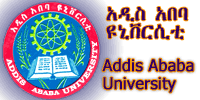Ethno-Anthropology and Culture
Taʾrīḫ Irītriyā ʾl-Muʿāṣir arḍan wa-šaʿban [The modern history of Eritrea] (1994)
by Muḥammad ʿUthmān Abū Bakr
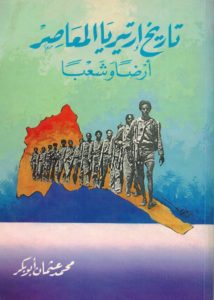
 al-Qāhirah : M.ʻU. Abū Bakr, pp. 220-231.
al-Qāhirah : M.ʻU. Abū Bakr, pp. 220-231.
In the chapter 6 of this book, Muḥammad ʿUthmān Abū Bakr (b. Xirhgiigo, 1945) describes the origin, the traditional social structure and the customs of the ethnic groups of Eritrea. One section is devoted to an accurate description of the Saho.
Tassonomia pastorale dei Saho ʻAsaorta: materiali coloniali [Pastoral taxonomy of the Saho ʻAsaorta: colonial materials] (2004)
By Gianni Dore
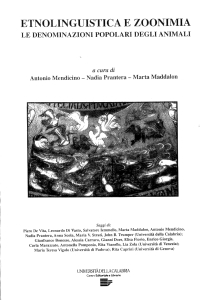
 From Antonio Mendicino, Nadia Pantera e Marta Maddalon (eds.)(2004) Etnolinguistica e Zoonimia. Le denominazioni popolari degli animali. Rende: Centro Editoriale e Librario. Università degli Studi della Calabria. Pp. 205-221
From Antonio Mendicino, Nadia Pantera e Marta Maddalon (eds.)(2004) Etnolinguistica e Zoonimia. Le denominazioni popolari degli animali. Rende: Centro Editoriale e Librario. Università degli Studi della Calabria. Pp. 205-221
Published with permission.
A new version of this article, reviewed and updated, is under preparation.
An encyclopedic lexicon of the Saho traditional knowledge on beekeeping (2009)
 By Moreno Vergari and Roberta Vergari
By Moreno Vergari and Roberta Vergari
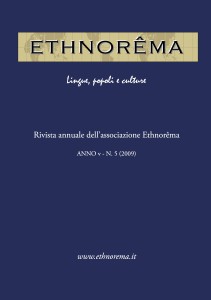 From Ethnorêma, 5 (2009): 61-88.
From Ethnorêma, 5 (2009): 61-88.
Beekeeping is one of the traditional productive activities for which the Saho population is well-known. Even though it is not practiced on a large scale, there still are several people who engage in honey production either for their personal consumption or for commercial purposes.
After independence Eritrea promoted a modernization policy of honey production techniques, with specific local training courses, but Saho beekeeping is still done mainly the traditional way. What an individual beekeper knows about it generally derives from his personal experience, or from what his father taught him. Accordingly, this lexicon documents the traditional terminology and knowledge as they have been told us by our informants. No attempt is made to provide a scientific description of their beekeeping activities, even if what they said was plainly wrong, e.g., the belief of some of them that queen bees are males.
The data in this lexicon are provisional, in the sense that they result from the field work that has been done by till now, covering southern varieties of Northern Saho and the two main varieties of Central Saho. The next field trips in Eritrea by the team of the Atlas of the Traditional Material Culture of the Saho project will attempt to elicit data in villages where the other varieties of Saho are spoken.
Field data have been collected in Eritrea from 1999 to 2009 by Moreno and Roberta Vergari (Ethnorêma). Interviews with the informants mentioned below have been carried out in January and February 2008 and 2009 by Ahmedsaad Mohammed Omer [Axmadsacad Maxammad Cumar] (Eritrean Field Coordinator), Giorgio Banti (University of Naples “L’Orientale”), Giovanni Dore (University of Venice “Ca’ Foscari), Moreno Vergari and Roberta Vergari. The Ministry of Education of the State of Eritrea (MoE) generously provided the project with all the necessary authorizations and logistic support for visiting the towns and villages in the Southern (Debub) Region. The Saho Panel of the Department of General Education of the MoE supported us with their expertise.
From the same page audio and video files can be downloaded.
ስን ቃል ህዝቢ ኢሮብ [Sǝnä-Qal Hǝzbi Irob “Terminology of the Irob people”] (2001 Ethiopian Calendar = 2008)
by Berhe Zigta
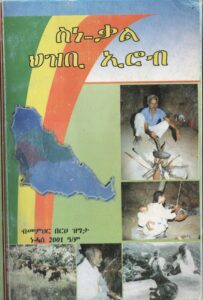 The book is divided in 21 paragraphs: Introduction; 1. Key; 1.1 Saho alphabet; 1.2 Alphabet list and usage; 1.3 Connectives, postpositions and adjectives; 1.4 Possessives; 1.5 Phrasal words; 2. Terminology; 2.1 Researches related to terminology; 2.2. Poetry; 2.3 Conversation; 2.4 Blessings in coffee ceremony; 2.5 Cattle appreciation; 2.6 Women churning milk; 2.7 Poetic appreciation with flute; 2.8 Traditional songs and echoing mottos; 2.9 Poems in Saho language; 2.10 Riddles; 2.11 Sayings of Irob people; 3. Proverbs of Irob people (a list of 894 proverbs); 4. References.
The book is divided in 21 paragraphs: Introduction; 1. Key; 1.1 Saho alphabet; 1.2 Alphabet list and usage; 1.3 Connectives, postpositions and adjectives; 1.4 Possessives; 1.5 Phrasal words; 2. Terminology; 2.1 Researches related to terminology; 2.2. Poetry; 2.3 Conversation; 2.4 Blessings in coffee ceremony; 2.5 Cattle appreciation; 2.6 Women churning milk; 2.7 Poetic appreciation with flute; 2.8 Traditional songs and echoing mottos; 2.9 Poems in Saho language; 2.10 Riddles; 2.11 Sayings of Irob people; 3. Proverbs of Irob people (a list of 894 proverbs); 4. References.
Self-published by the author in Dhawhan.
“C’è l’Assaorta che ci aspetta…”. Geografi ed etnografi italiani tra i Saho d’Eritrea [“There is the Assaorta that is waiting us…” Italian geographers and ethnographers among the Saho of Eritrea] (2009)
By Gianni Dore

 From Ethnorêma, 5 (2009): 11-28.
From Ethnorêma, 5 (2009): 11-28.
At the very beginning of the XX c. four Italian geographers and ethnologists reached Eritrea to do a scientific survey of several Saho groups. Their aim was to collect data on Saho material culture, as well as on their myths of origins, historical accounts, riddles, and genealogies. They sought support for their research insisting that it would also be useful to colonial administrators. This essay takes into account the methodology of their inquiry, the colonial practices and sheds light on the complex and ambiguous relationship between researchers, colonial officers, local chiefs and inhabitants in the Akkälä Guzai region in that early stage of Italian colonial rule. As a product of that mission a rich ethnographic collection of Saho handcrafts reached Florence where it was kept in the Museum of Anthropology and partly exhibited. It is a remarkable resource on the Saho cultural heritage. That old mission and its results are the scientific basis on which today’s field research mission with its own linguistic and ethnographic goals is based.
Source: https://www.ethnorema.it/wp-content/uploads/5-04-Dore-1.pdf
The Saho of Eritrea and the documentation of their language and cultural heritage (2010)
By Giorgio Banti and Moreno Vergari

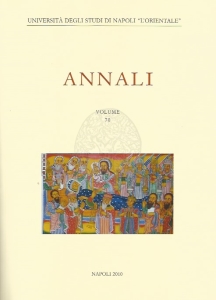 From Annali dell’Università degli Studi di Napoli “L’Orientale”. Rivista del Dipartimento di Studi Asiatici e del Dipartimento di Studi e Ricerche su Africa e Paesi Arabi, vol. 70 (2013 [2010]). Pp. 83-108.
From Annali dell’Università degli Studi di Napoli “L’Orientale”. Rivista del Dipartimento di Studi Asiatici e del Dipartimento di Studi e Ricerche su Africa e Paesi Arabi, vol. 70 (2013 [2010]). Pp. 83-108.
The use of indigenous communication approaches for Hiv/Aids prevention in Erob woreda, North Eastern Tigray (2010)
By Hagos Nigussie
 M.A. Thesis (School of Graduate Studies – Addis Ababa University)
M.A. Thesis (School of Graduate Studies – Addis Ababa University)
This paper examines the use of indigenous communication channels for HIV/AIDS prevention strategies in Erob woreda, Eastern Zone of Tigray. To this part, Qualitative Research and mainly Case Study was employed to explore the communication strategies, the folk media forms, the appropriateness of the currently employed channels of communication and the nature of the language of intervention communication for the epidemic prevention. The study used individual in-depth interviews, focus group discussions and participant observation for generating data from two sub- districts of the woreda namely Daya-Alitena and Ingal areas. With this, the paper attempted to examine different scholarly observations, theories and models to the significance of folk media in development communication. Hence, the findings from the study indicate that the communities use different forms of folk media in their day to day needs and believe them as potential conduits for any societal concerns. However, when it comes to the communication strategies and their appropriateness for the intervention programs, it lacks to employ folk media channels though most practitioners know them. In terms of community participation in the programs, it is revealed that the people’s literacy levels and the types of intervention channels remained incompatible. There is also language barrier as most intervention programs are carried out using Tigrigna language to which a number of the Erob communities don’t comprehend. Consequently, the overall result of the study signifies that; little use of folk media channels, low level of community participation due to limited knowledge about the epidemic, and the language of the intervention programs itself appear to make the intervention programs less effective in the woreda (from the abstract).
Source: http://etd.aau.edu.et/bitstream/123456789/7342/1/Hagos%20%20Final%20Thesis.pdf
ባህልን ቋንቋን ህዝቢ ኢሮብ [Bahlǝn Qwanqwan Hǝzbi Irob “Custom and language of the Irob people”] (2003 Ethiopian Calendar = 2010)
by Berhe Zigta
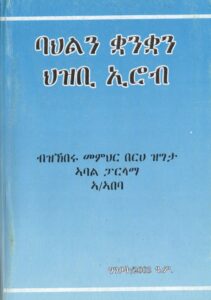
Content of the book: Introduction; Acknowledgment: 1. Culture of Irob people; 1.1 Tradition and custom of the Irob people; 1.2 Traditional food; 1.3 Traditional dressing; 1.4 Traditional play; 1.5 Hospitality of guests; 1.6 “Geleb” ceremony; 1.7 Funeral ceremony; 1.8 Traditional food containers; 2. “Mesqel” ceremony; 2.1 Treatment of cattle during Mesqel ceremony; 2.2 “cakhokhay”; 2.3 “liciyo” (taking cattle out early in the morning on the day of mesqel); 2.4 Milk in “cakhokhay” ceremony; 2.5 Barbecue “soola”; 2.6 Women in mesqel day; 2.7 “Orba” (groom’s visit); 3. Traditional wedlock (marriage); 3.1 Traditional wedlock of Christian religion’s followers; 3.1.1 Engagement; 3.1.2 Wedding’s contract; 3.1.3 Wedding; 3.1.4 Dowry; 3.1.5 Become a man (kind of rite of passage); 3.1.6 Exposing (of the bride); 3.1.7 Honeymoon (xitstsinot); 3.1.8 Orba; 3.1.9 Mother-in-law’s pity (towards the bridegroom); 3.1.10 Exit of the house (separation from the original parent’s house to begin a new family); 3.2 Traditional wedlock of Islam religion’s followers; 4. Backward traditional culture; 4.1 Uraye (third day funeral ceremony); 4.2 Wedding; 4.3 Mourning; 4.4 Tobacco; 4.5 Borrowing; 4.6 Corruption; 4.6.1 Educational corruption; 4.7 Expectance; 4.8 Gender discrimination; 4.8.1 Role of gender in country’s development; 5. Personal and democratic rights; 6. AIDS and its consequences; 7. Language; 7.1 Features of a language; 7.2 Speaking and visiting; 7.3 Language and culture; 7.4 Language and society; 7.5 Language and democracy; 7.6 Language and education; 7.7 Language and Irob people; 7.7.1 Nominating names in language of Irob people
Self-published by the author in Addis Abeba.
Conflict Resolution and Customary Law in Contemporary Eritrea: Case Studies of the Saho Community (2015)
By Abdulkader Saleh Mohammad and Nicole Hirt
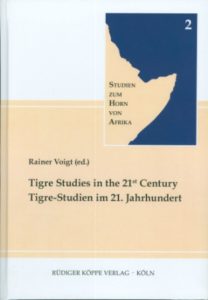
 From: Rainer Voigt (ed.): Tigre Studies in the 21st Century / Tigre-Studien im 21. Jahrhundert, Studien zum Horn von Afrika, 2, Köln 2015, pp. 153–168.
From: Rainer Voigt (ed.): Tigre Studies in the 21st Century / Tigre-Studien im 21. Jahrhundert, Studien zum Horn von Afrika, 2, Köln 2015, pp. 153–168.
The Eritrean society is composed of nine ethnic groups who are heterogeneous in na- ture, based on a variety of languages and cultures. Each ethnic group practices different belief systems and various customary laws, which are framed and administered by elder- ly, religious and wise men of the concerned groups. This paper will elaborate the origins of the Saho speaking groups, their traditional rules and regulations. Although the his- torical trace of their customary law is not clearly known, most elders and ʿuqqāls1 of the Saho people claim that it is older than the era of the Islam. This traditional law was pre- served orally among the community and was passed on from generation to generation. Only during the period of the British colonial administration, this oral traditional cul- ture was collected, recorded and written down in 1943. The Saho as agro-pastoralists maintained their self-governance system for long periods, and this should be seen as a base of historical development of the customary law, which was respected and applied by all Saho tribes. The traditional conflict and tension mediation system continued to be practiced during the European and Ethiopian colonial administrations, especially on the local level. The paper will also discuss the relevance of this law in the modern State of Eritrea, and how the government tolerates the traditional forms of social organisation and conflict mediation systems. In addition, the paper will demonstrate the functionali- ty of the law by presenting different case studies.
Published with permission.
Rapporti socio-produttivi tra agricoltori tigrini e pastori saho d’Eritrea. L’evoluzione dell’abitazione saho dalla daasa alla naxsa [Socio-productive relations between Tigreans farmers and Saho pastoralists of Eritrea. The evolution of Saho dwelling from daasa to naxsa] (2015)
By Gianni Dore
 From Fra
From Fra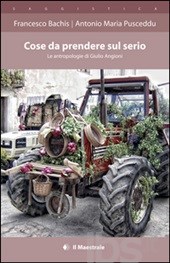 ncesco Bachis and Antonio Maria Pusceddu (eds.) (2015) Cose da prendere sul serio. Le antropologie di Giulio Angioni. Nuoro: Edizioni Il Maestrale. Pp. 157-169.
ncesco Bachis and Antonio Maria Pusceddu (eds.) (2015) Cose da prendere sul serio. Le antropologie di Giulio Angioni. Nuoro: Edizioni Il Maestrale. Pp. 157-169.
Identità, ibridazione ed evoluzione dell’abitare tra i Saho di Eritrea e Etiopia [Identity, hybridization and evolution of the dwelling among the Saho of Eritrea and Ethiopia] (2016)
by Gianni Dore and Moreno Vergari
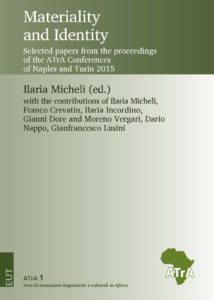
 From Ilaria Micheli [ed.] Materiality and Identity. Selected papers from the proceedings of the ATrA Conferences of Naples and Turin 2015. Trieste: EUT. Pp. 93-123
From Ilaria Micheli [ed.] Materiality and Identity. Selected papers from the proceedings of the ATrA Conferences of Naples and Turin 2015. Trieste: EUT. Pp. 93-123
Il saggio ripercorre i passaggi storici dei modi dell’abitare e della morfologia e struttura delle case tra i gruppi parlanti la lingua saho in Eritrea e in Etiopia. Le ipotesi e ricostruzioni storiche proposte si basano sull’esame di un ampio materiale documentario, scritto, orale e iconografico. Le etichette linguistiche, i modi espressivi e la letteratura orale formalizzata permettono di penetrare nella cultura e ideologia dell’abitare e nelle complesse dinamiche della divisione sessuata degli spazi e del lavoro. L’esperienza pastorale, con le transumanze da e verso il bassopiano dancalo, i suoi ritmi ed esigenze tecniche, ha segnato profondamente per un lunghissimo periodo i modelli abitativi. Sono descritte, con le loro variazioni locali o temporali, con attenzione al loro lessico specifico, le abitazioni mobili e temporanee, gli adat- tamenti progressivi e creativi, nel passaggio a un agro-pastoralismo, verso la casa fattoria dei contadini tigrinofoni, e infine i decisivi cambiamenti materiali e ideologici verso nuovi modelli di casa e dell’abitare.
Source: http://www.openstarts.units.it/dspace/handle/10077/13004
SEE ALSO: http://www.sahoarchive.org/history/
Sedentarization and the Creation of Alternative Livelihood among Saho Pastoralists in the Qohaito Plateau of Eritrea (2017)
by Robel Haile
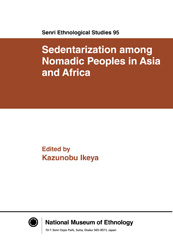
 From Senri Ethnological Studies, 95:293-318
From Senri Ethnological Studies, 95:293-318
Abstract: Owing to several interacting exogenous and endogenous (Fratkin and Roth 2010), or push and pull factors (Eneyew 2012), the reduction of mobility among the traditional pastoral societies in the East Africa led to higher rate of sedentarization phenomena, and transition to alternative livelihoods. Some of the causal factors for the occurrence of rapid sedentarization include shrinking pastures, frequent national and regional conflicts, and recurrent drought (Fratkin 1997, 2001; Fratkin and Ikeya 2005; Eneyew 2012), commoditization of livestock (Fratkin 1997), the introduction of modern institutions, and the emergence of new forms of inter- community relationships. The fast sedentarization led to another collateral process, i.e. the need to create an alternative livelihood for the former pastoral societies, who either co-practice pastoralism together with other economic activities, or totally replaced pastoralism with other subsistence activities. As Elliot Fratkin and Eric Roth (2010) noted, the processes of sedentarization and the creation of alternative livelihood are tightly interconnected because the former acts as the direct precursor of the latter. The Saho sedentarization process in Qohaito Plateau illustrates the causal relationship of modernity, colonialism and postcolonial conflict in the transformation of the society towards sedentism. This article examines the historical process of the formation of sedentary villages in the plateau. A combination of oral history, settlement and ethnographic data demonstrate that the Italian colonial era laid the foundation for the formation of sedentary villages in the plateau, and ever since the process intensified parallel to the introduction of alternative mechanism. To establish a concrete empirical measure to the ongoing sedentarization process in Qohaito, this article emphasizes the food consumption and the dependence of the inhabitant on non-pastoral food as a parameter to indicate the scale of the sedentarization.
Gendered spaces, grindstones and baking among the Saho-speaking communities (2018)
by Gianni Dore and Moreno Vergari
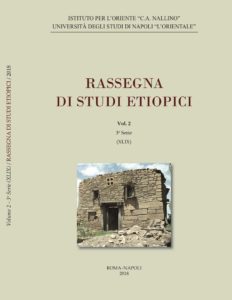
 from Rassegna di Studi Etiopici, vol. 2 (2018), pp. 41-82
from Rassegna di Studi Etiopici, vol. 2 (2018), pp. 41-82
Abstract: This essay studies the grinding process and grindstones in the context of housing and dwelling among the Saho-speaking communities in a historical and comparative perspective. This cultural experience should be inserted and interpreted in a broader context which is the Eritrean eastern slopes and the macro-region of Tәgray. Ethno- archaeologists did field research in north-eastern Tәgray interviewing severalhousekeepers on grinding and food processing comparing their information with the archaeological records. They provided a deep analysis of the complex relations be- tween gender, domestic spaces, grinding and cooking in a specific sociological and ecological milieu. Comparing our field information with the bulk of data of the con- temporary ethnoarchaeological studies we can better understand the similar material culture of the Saho-speaking communities in a larger technological continuum, albe- it a specific lexicon at least among the Saho of Eritrea has been documented. In fact the lexicon related to the grinding process of the Irob living east of ʿAddigrat is al- most identical to the Tigrayan one. The glossary alleged here is an adapted selection from the richer one which will be published in the forthcoming monograph on dwelling and housing among the Saho-speaking communities.
The Mäsqäl feast among the Irob of Ethiopia (2018)
by Moreno Vergari
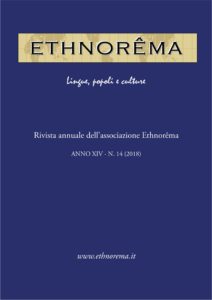
 from Ethnorêma, vol. 14 (2018), pp. 99-117.
from Ethnorêma, vol. 14 (2018), pp. 99-117.
These pictures show the celebration of the feast of the Mäsqäl in the villages of Alitena (photos 4-26, 33), Dawhan (photos 1-3) and Kallaʿasa1 (photos 27-32), among the Saho- speaking community of the Irob, living in the Irob wäräda of the Tǝgray region of Ethiopia. The Mäsqäl (lit. ‘Cross’), the “Feast of the Finding of the True Cross”, is one of the most commonly observed religious feasts in Ethiopia, both by the Orthodox and the Catholic communities. It is celebrated on the 17th of Mäskäräm of the Ethiopic calendar, corresponding to the 27th of September in the Gregorian one.
Source: https://www.ethnorema.it/wp-content/uploads/14-07-Mondofoto.pdf
Towards the Saho Anthroponymy: A study of the Semantic and Cultural Aspects of Saho Personal Names (2020)
by Moses James Olenyo Malante and Omer Romodan Omer
from Amutabi, MN and Magdalene, N. (eds.) Strategic Governance and Sustainable Development in Africa (2020). Nairobi: Cedred Publications. Pp.298-311
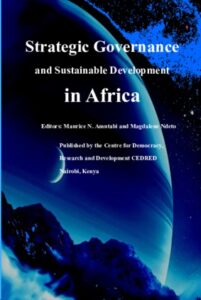
 This paper attempts an anthroponomy study on the semantics and cultural aspects of Saho personal names. Saho is a semetic language spoken in the horn of Africa region of Ethiopia and Eritrea. This paper establishes the meanings and the socio-cultural issues encoded in Saho personal names. Additionally, social cultural activities surrounding the naming process and naming trends are highlighted. This study makes a finding that Saho personal names aren’t mere arbitrary symbols but in fact do point out to an individual’s ancestry-family, clan, and the in- group and out-group identities that demarcate dialectal boundaries across the Saho dialects hence making personal names of greater significance to Saho community. Therefore maintaining these naming histories, together with the procedures and processes involved (just as is the case of this paper) is important for Saho personal name preservation.
This paper attempts an anthroponomy study on the semantics and cultural aspects of Saho personal names. Saho is a semetic language spoken in the horn of Africa region of Ethiopia and Eritrea. This paper establishes the meanings and the socio-cultural issues encoded in Saho personal names. Additionally, social cultural activities surrounding the naming process and naming trends are highlighted. This study makes a finding that Saho personal names aren’t mere arbitrary symbols but in fact do point out to an individual’s ancestry-family, clan, and the in- group and out-group identities that demarcate dialectal boundaries across the Saho dialects hence making personal names of greater significance to Saho community. Therefore maintaining these naming histories, together with the procedures and processes involved (just as is the case of this paper) is important for Saho personal name preservation.
Source: https://www.academia.edu/45594052/Towards_the_Saho_Anthroponymy_and_Making_Meaning_from_Naming_Trends_A_study_of_the_Semantics_and_Cultural_Aspects_of_Saho_Personal_Names
Back to the Village: Integrating Folk Media into Rural Food Security Communication in Ethiopia (2021)
by Hagos Nigussie
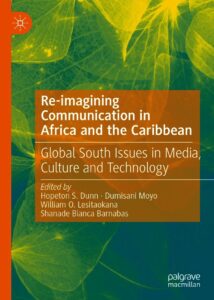 From: Dunn, H.S., Moyo, D., Lesitaokana, W.O., Barnabas, S.B. (eds.) Re-imagining Communication in Africa and the Caribbean (2021) Palgrave Macmillan, Cham. Pp. 273-292.
From: Dunn, H.S., Moyo, D., Lesitaokana, W.O., Barnabas, S.B. (eds.) Re-imagining Communication in Africa and the Caribbean (2021) Palgrave Macmillan, Cham. Pp. 273-292.
Ethiopia is one of the most food-insecure nations in Sub-Saharan Africa. The Ethiopian government has introduced various policies and strategies to alleviate rural food insecurity. Yet, top-down communication approaches applied to take these strategies to rural communities have been seemingly ineffective. Using the multiplicity paradigm of development, this chapter explores the adaptability of folk media forms to integrate into food security communication in eastern Tigray, rural Ethiopia. The study shows that Aa’dar (oral poetry) and Goila (folk songs) have the highest potential to convey rural food security messages due to their entertainment and educational value. These folk media forms have the adaptability to integrate into food security communication due to their feedback system, a high degree of credibility, embeddedness in the language and culture of locals, understandability and ability to cover different themes.
Source: https://link.springer.com/chapter/10.1007/978-3-030-54169-9_15
Housing and dwelling among the Saho-speaking communities of Eritrea and Ethiopia. History, anthropology and lexicography (2022)
by Moreno Vergari (ed.), with the contributions of Ahmedsaad Mohammed Omer, Giorgio Banti, Gianni Dore, Moreno Vergari and Roberta Vergari
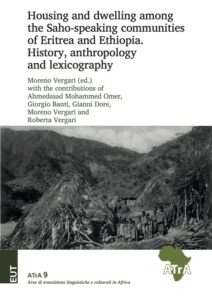
 This book is the results of field research among the Saho-speaking communities of Eritrea and Ethiopia by a linguists and anthropologists from the non-profit association “Ethnorêma”, the University of Naples L’Orientale, the Ca’ Foscari University of Venice and local institutions. It is a product of the “Atlas of the Traditional Material Culture of the Saho” project, which aims at documenting the traditional material culture of the Saho, its variation and terminology across the different Saho-speaking communities of Eritrea and northern Ethiopia, and the more general dialect variation in phonology, grammar and the lexicon. In particular, this volume describes the Saho speakers’ knowledge of construction techniques and its lexicon, sociofamilial aspects related to dwelling and the daily activities associated in types of residences and their outbuildings. Comparison with research from the early 20th century provides a diachronic dimension, while the data elicited in some 20 different localities ensure synchronic depth, with a focus on dialectal variation. After a general introduction, Gianni Dore’s contribution is an extensive historical-anthropological description of these issues. Moreno and Roberta Vergari, and Ahmedsaad Mohammed Omer’s one is a rich encyclopedic lexicon of the terms related to dwelling and household activities.
This book is the results of field research among the Saho-speaking communities of Eritrea and Ethiopia by a linguists and anthropologists from the non-profit association “Ethnorêma”, the University of Naples L’Orientale, the Ca’ Foscari University of Venice and local institutions. It is a product of the “Atlas of the Traditional Material Culture of the Saho” project, which aims at documenting the traditional material culture of the Saho, its variation and terminology across the different Saho-speaking communities of Eritrea and northern Ethiopia, and the more general dialect variation in phonology, grammar and the lexicon. In particular, this volume describes the Saho speakers’ knowledge of construction techniques and its lexicon, sociofamilial aspects related to dwelling and the daily activities associated in types of residences and their outbuildings. Comparison with research from the early 20th century provides a diachronic dimension, while the data elicited in some 20 different localities ensure synchronic depth, with a focus on dialectal variation. After a general introduction, Gianni Dore’s contribution is an extensive historical-anthropological description of these issues. Moreno and Roberta Vergari, and Ahmedsaad Mohammed Omer’s one is a rich encyclopedic lexicon of the terms related to dwelling and household activities.

